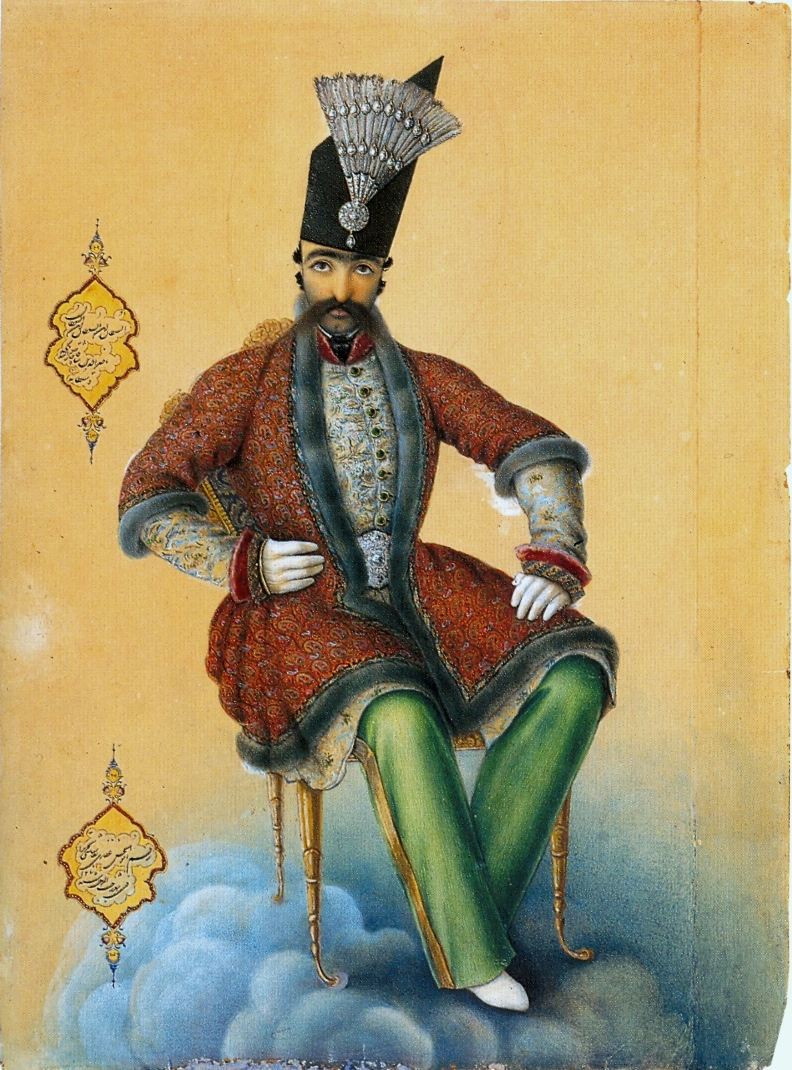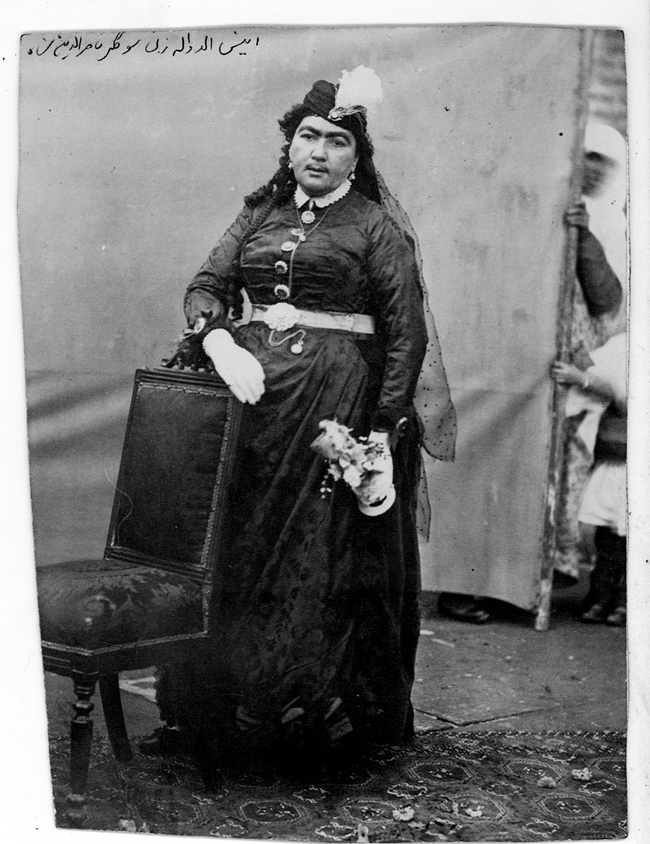|
Amina Aqdas
Amina Aqdas (Persian: امینه اقدس) (died 1893) was a royal consort of Naser al-Din Shah Qajar of Iran (r. 1848–1896).G. Nashat,Amīna Aqdas" Encyclopædia Iranica, I/9, pp. 954-955, accessed on 30 December 2012. She was the daughter of an impoverished shepherd from a village near Garrūs in Kurdistan, and was employed as a free maidservant to the shah's wife Anīs-al-dawla in the Qajar harem in 1859. She eventually became a favorite of the shah, second only to Anīs-al-dawla. Contemporaries attributed her influence to an ability to manipulate the shah's weak spots: she catered to his whims, encouraged his obsessions, and appealed to his parsimony. Her power was also enhanced by the shah's intense attachment to her nephew, Gholam-Ali, Malijak-e Thani, also known as Aziz Al-Soltan. She supported the career of Mirza Ali Asghar Khan Amin al-Soltan. She was entrusted with several important responsibilities, such as supervising the shah's private apartment, where the crown ... [...More Info...] [...Related Items...] OR: [Wikipedia] [Google] [Baidu] |
Naser Al-Din Shah Qajar
Naser al-Din Shah Qajar (; ; 17 July 1831 – 1 May 1896) was the fourth Shah of Qajar Iran from 5 September 1848 to 1 May 1896 when he was assassinated. During his rule there was internal pressure from the people of Iran, as well as external pressure from the British empire and the Russian empire. He granted many concessions, most importantly the Reuter concession and the Tobacco concession. He allowed the establishment of newspapers in the country and made use of modern forms of technology such as telegraph, photography and also planned concessions for railways and irrigation works. Despite his modernizing reforms on education, his tax reforms were abused by people in power, and the government was viewed as corrupt and unable to protect commoners from abuse by the upper classes which led to increasing anti-governmental sentiments. He was assassinated when visiting a shrine in Rayy near Tehran. He was the first modern Iranian monarch who formally visited Europe and wrote of ... [...More Info...] [...Related Items...] OR: [Wikipedia] [Google] [Baidu] |
Qajar Iran
The Guarded Domains of Iran, alternatively the Sublime State of Iran and commonly called Qajar Iran, Qajar Persia or the Qajar Empire, was the Iranian state under the rule of the Qajar dynasty, which was of Turkic peoples, Turkic origin,Cyrus Ghani. ''Iran and the Rise of the Reza Shah: From Qajar Collapse to Pahlavi Power'', I. B. Tauris, 2000, , p. 1William Bayne Fisher. ''Cambridge History of Iran'', Cambridge University Press, 1993, p. 344, Dr Parviz Kambin, ''A History of the Iranian Plateau: Rise and Fall of an Empire'', Universe, 2011, p.36online edition specifically from the Qajar (tribe), Qajar tribe, from 1789 to 1925. The Qajar family played a pivotal role in the Unification of Iran (1779–1796), deposing Lotf 'Ali Khan, the last Shah of the Zand dynasty, and re-asserted Iranian sovereignty over large parts of the Caucasus. In 1796, Agha Mohammad Khan Qajar seized Mashhad with ease, putting an end to the Afsharid dynasty. He was formally crowned as Shah after his Batt ... [...More Info...] [...Related Items...] OR: [Wikipedia] [Google] [Baidu] |
Anīs-al-dawla
file:ملیجک_و_انیسالدوله.jpg, link=https://fa.wikipedia.org/wiki/%D9%BE%D8%B1%D9%88%D9%86%D8%AF%D9%87:%D9%85%D9%84%DB%8C%D8%AC%DA%A9_%D9%88_%D8%A7%D9%86%DB%8C%D8%B3%E2%80%8C%D8%A7%D9%84%D8%AF%D9%88%D9%84%D9%87.jpg, 232x232px, Anis al-Dawla and Aziz al-Soltan Anis al-Dawla (Persian: انیسالدوله) (''c''. 1842 - 1896) was a royal consort of Naser al-Din Shah Qajar of Qajar Iran, Iran (r. 1848–1896).Nashat, G. (5 August 2011) “ANĪS-AL-DAWLA,” Encyclopædia Iranica, II/1, pp. 74-76, available online at http://www.iranicaonline.org/articles/anis-al-dawla-d (accessed on 30 December 2012). Life She was born c. 1842 and was the daughter of an impoverished shepherd from Amamme village in Lavāsān, northeast of Tehran, and was employed as a free maidservant to Jeyrān in the Qajar harem in 1859. She became the favorite of the shah after Jeyrān's death in 1860. She was the only wife to take meals with Nāṣer-al-dīn, a unique privilege, and to joi ... [...More Info...] [...Related Items...] OR: [Wikipedia] [Google] [Baidu] |
Qajar Harem
The harem of the monarchs of the Qajar dynasty (1785-1925) consisted of several thousand people. The harem had a precise internal administration, based on the women's rank. Hierarchy and organisation Mother of the Shah As was customary in Muslim harems, the highest rank of the harem hierarchy was that of the monarch's mother, who in Qajar Iran had the title ''Mahd-e ʿOlyā'' (Sublime Cradle). She had many duties and prerogatives, such as safeguarding the harem valuables, particularly the jewels, which she administered with the help of female secretaries. Consorts In contrast to what was common in the Ottoman Empire, where the sultans normally only had slave consorts, the Qajar shahs also had a custom of diplomatic marriages with free Muslim women, daughters of Qajar dignitaries and princes. Another phenomena of the Qajar harem was that the Shah entered two different kinds of marriages with his harem women: '' ṣīḡa'' (temporary wife), which was often done with concubines, ... [...More Info...] [...Related Items...] OR: [Wikipedia] [Google] [Baidu] |
Mirza Ali Asghar Khan Amin Al-Soltan
Mirza Ali Asghar Khan (; 6 January 1858 – 31 August 1907), also known by his honorific titles of Amin al-Soltan and Atabak, served as Prime Minister of Iran from 1887 to 1896 under Naser ed-Din Shah Qajar, from 1898 to 1904 under Mozaffar ed-Din Shah Qajar and from May 1907 until his assassination in August 1907 under Moahammad Ali Shah Qajar. Early life Ali Asghar was born on 6 January 1858. He was the second son of Agha Ebrahim, an influential court minister of Georgian origin. When Ali Asghar was 15 years old, he began helping his father in politics. The next year, Ali Asghar and his father accompanied Naser al-Din Shah to his pilgrimage to the holy Shi'a cities of Najaf, Karbala, Kadhimiya, and Samarra. When Ali Asghar returned to his native Tehran, he was promoted to commander of the royal escort cavalry, and in the following years continued to rise to higher offices, eventually being promoted to the treasurer of the army. After the death of his father in 1883, h ... [...More Info...] [...Related Items...] OR: [Wikipedia] [Google] [Baidu] |
Ulama
In Islam, the ''ulama'' ( ; also spelled ''ulema''; ; singular ; feminine singular , plural ) are scholars of Islamic doctrine and law. They are considered the guardians, transmitters, and interpreters of religious knowledge in Islam. "Ulama" may refer broadly to the educated class of such religious scholars, including Theology, theologians, Religious law, canon lawyers (muftis), judges (qadis), professors, and high state religious officials. Alternatively, "ulama" may refer specifically to those holding governmental positions in an Islamic state. By longstanding tradition, ulama are educated in religious institutions (''madrasas''). The Quran and sunnah (authentic hadith) are the scriptural sources of Sharia, traditional Islamic law. Traditional way of education Students of Islamic doctrine do not seek out a specific educational institution, but rather seek to join renowned teachers. By tradition, a scholar who has completed their studies is approved by their teacher. At ... [...More Info...] [...Related Items...] OR: [Wikipedia] [Google] [Baidu] |
1893 Deaths
Events January * January 2 – Webb C. Ball introduces railroad chronometers, which become the general railroad timepiece standards in North America. * January 6 – The Washington National Cathedral is chartered by Congress; the charter is signed by President Benjamin Harrison. * January 13 ** The Independent Labour Party of the United Kingdom has its first meeting. ** U.S. Marines from the ''USS Boston'' land in Honolulu, Hawaii, to prevent the queen from abrogating the Bayonet Constitution. * January 15 – The ''Telefon Hírmondó'' service starts with around 60 subscribers, in Budapest. * January 17 – Overthrow of the Kingdom of Hawaii: Lorrin A. Thurston and the Committee of Safety (Hawaii), Citizen's Committee of Public Safety in Hawaii, with the intervention of the United States Marine Corps, overthrow the government of Queen Liliuokalani. * January 21 – The Tati Concessions Land, formerly part of Matabeleland, is formally annexed to the Bec ... [...More Info...] [...Related Items...] OR: [Wikipedia] [Google] [Baidu] |
Qajar Royal Consorts
The Guarded Domains of Iran, alternatively the Sublime State of Iran and commonly called Qajar Iran, Qajar Persia or the Qajar Empire, was the Iranian state under the rule of the Qajar dynasty, which was of Turkic peoples, Turkic origin,Cyrus Ghani. ''Iran and the Rise of the Reza Shah: From Qajar Collapse to Pahlavi Power'', I. B. Tauris, 2000, , p. 1William Bayne Fisher. ''Cambridge History of Iran'', Cambridge University Press, 1993, p. 344, Dr Parviz Kambin, ''A History of the Iranian Plateau: Rise and Fall of an Empire'', Universe, 2011, p.36online edition specifically from the Qajar (tribe), Qajar tribe, from 1789 to 1925. The Qajar family played a pivotal role in the Unification of Iran (1779–1796), deposing Lotf 'Ali Khan, the last Shah of the Zand dynasty, and re-asserted Iranian sovereignty over large parts of the Caucasus. In 1796, Agha Mohammad Khan Qajar seized Mashhad with ease, putting an end to the Afsharid dynasty. He was formally crowned as Shah after his Batt ... [...More Info...] [...Related Items...] OR: [Wikipedia] [Google] [Baidu] |
19th-century Iranian Women
The 19th century began on 1 January 1801 (represented by the Roman numerals MDCCCI), and ended on 31 December 1900 (MCM). It was the 9th century of the 2nd millennium. It was characterized by vast social upheaval. Slavery was Abolitionism, abolished in much of Europe and the Americas. The First Industrial Revolution, though it began in the late 18th century, expanded beyond its British homeland for the first time during the 19th century, particularly remaking the economies and societies of the Low Countries, France, the Rhineland, Northern Italy, and the Northeastern United States. A few decades later, the Second Industrial Revolution led to ever more massive urbanization and much higher levels of productivity, profit, and prosperity, a pattern that continued into the 20th century. The Catholic Church, in response to the growing influence and power of modernism, secularism and materialism, formed the First Vatican Council in the late 19th century to deal with such problems an ... [...More Info...] [...Related Items...] OR: [Wikipedia] [Google] [Baidu] |





